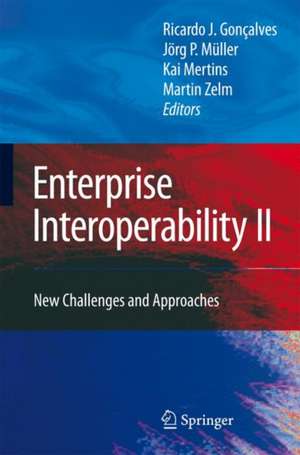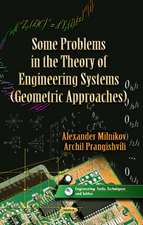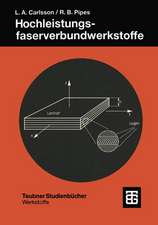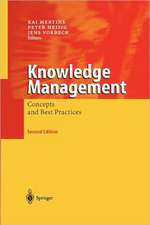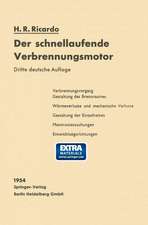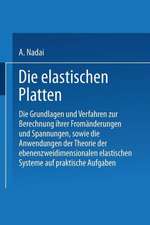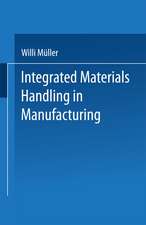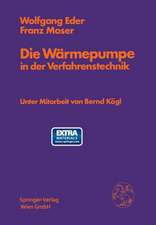Enterprise Interoperability II: New Challenges and Approaches: Proceedings of the I-ESA Conferences, cartea 3
Editat de Ricardo Jardim-Gonçalves, Jörg Müller, Kai Mertins, Martin Zelmen Limba Engleză Hardback – 16 mar 2007
Composed of over 90 papers, Enterprise Interoperability II ranges from academic research through case studies to industrial and administrative experience of interoperability. The international nature of the authorship continues to broaden. Many of the papers have examples and illustrations calculated to deepen understanding and generate new ideas.
A concise reference to the state of the art in software interoperability, Enterprise Interoperability II will be of great value to engineers and computer scientists working in manufacturing and other process industries and to software engineers and electronic and manufacturing engineers working in the academic environment.
| Toate formatele și edițiile | Preț | Express |
|---|---|---|
| Paperback (1) | 1844.99 lei 6-8 săpt. | |
| SPRINGER LONDON – 27 sep 2016 | 1844.99 lei 6-8 săpt. | |
| Hardback (1) | 1851.62 lei 6-8 săpt. | |
| SPRINGER LONDON – 16 mar 2007 | 1851.62 lei 6-8 săpt. |
Preț: 1851.62 lei
Preț vechi: 2258.08 lei
-18% Nou
Puncte Express: 2777
Preț estimativ în valută:
354.35€ • 384.77$ • 297.65£
354.35€ • 384.77$ • 297.65£
Carte tipărită la comandă
Livrare economică 22 aprilie-06 mai
Preluare comenzi: 021 569.72.76
Specificații
ISBN-13: 9781846288579
ISBN-10: 1846288576
Pagini: 916
Ilustrații: XVII, 894 p.
Dimensiuni: 155 x 235 x 60 mm
Greutate: 1.45 kg
Ediția:2007
Editura: SPRINGER LONDON
Colecția Springer
Seria Proceedings of the I-ESA Conferences
Locul publicării:London, United Kingdom
ISBN-10: 1846288576
Pagini: 916
Ilustrații: XVII, 894 p.
Dimensiuni: 155 x 235 x 60 mm
Greutate: 1.45 kg
Ediția:2007
Editura: SPRINGER LONDON
Colecția Springer
Seria Proceedings of the I-ESA Conferences
Locul publicării:London, United Kingdom
Public țintă
ResearchCuprins
Enterprise Modelling and Interoperability Engineering.- Distributed, Decentralized and Adaptable Interoperability Architecture.- Tools and Methodologies for Enterprise Interoperability.- Semantics and Knowledge Aspects in Enterprise Interoperability.- Model-driven and Service-oriented Integration and Development.- Collaborative Architecture and Formal Interoperability Approaches.- Managing, Measuring and Validating Interoperability.- Cross-sector Interoperability Solutions.- Applications, Case Studies, Best Practice and Standards.
Notă biografică
Prof. Dr. Jörg P. Müller holds a Chair for Business Information Technology at Technical University of Clausthal. Previously, Jörg was Principal Researcher with Siemens AG, John Wiley & Sons, Zuno Ltd., Mitsubishi Electric, and the German Artificial Intelligence Research Center. He holds a Ph.D. from Saarbrücken University and an M.Sc. in Computer Science from Kaiserslautern University. Within the last fifteen years, he has published more than 100 papers on intelligent agents and multi-agent systems, business information systems and distributed computing. His current research interests include technologies for interoperability, model-driven business process automation, and business applications of agent technology, peer-to-peer and grid computing.
Textul de pe ultima copertă
Interoperability: the ability of a system or a product to work with other systems or products without special effort from the user is a key issue in manufacturing and industrial enterprise generally. It is fundamental to the production of goods and services quickly and at low cost at the same time as maintaining levels of quality and customisation. Interoperability is achieved if internal and external collaborators can interact on at least three levels: data, applications and business enterprise (through the architecture of an enterprise model and making allowance for the semantics of both partners). Not only a problem of software and IT technologies, it implies support for communication and transactions between different organisations that must be based on shared business references. Today, a new and important consideration must be taken into account – economic business evaluation and the definition of dissemination policy.
Composed of over 90 papers, Enterprise Interoperability II ranges from academic research through case studies to industrial and administrative experience of interoperability. The international nature of the authorship continues to broaden. Many of the papers have examples and illustrations calculated to deepen understanding and generate new ideas.
The I-ESA’07 conference from which this book is drawn was sponsored by the European Union via the INTEROP network of excellence and the ATHENA integrated project (in the frame of the 6th IST Framework Research Program). It is also supported by the International Federation for Information Processing, the International Federation of Automatic Control and various national associations.
A concise reference to the state of the art in software interoperability, Enterprise Interoperability II will be of great value to engineers and computer scientists working in manufacturing and other process industries and to software engineers and electronic andmanufacturing engineers working in the academic environment.
Composed of over 90 papers, Enterprise Interoperability II ranges from academic research through case studies to industrial and administrative experience of interoperability. The international nature of the authorship continues to broaden. Many of the papers have examples and illustrations calculated to deepen understanding and generate new ideas.
The I-ESA’07 conference from which this book is drawn was sponsored by the European Union via the INTEROP network of excellence and the ATHENA integrated project (in the frame of the 6th IST Framework Research Program). It is also supported by the International Federation for Information Processing, the International Federation of Automatic Control and various national associations.
A concise reference to the state of the art in software interoperability, Enterprise Interoperability II will be of great value to engineers and computer scientists working in manufacturing and other process industries and to software engineers and electronic andmanufacturing engineers working in the academic environment.
Caracteristici
Keeps the reader up to date with developments in a field which is extremely important for industrial competitiveness International author pool means that readers can learn about the environment in many countries with which they may have to co-operate Inter-disciplinary subject matter allows the reader to learn about many points of view on similar problems Includes supplementary material: sn.pub/extras
